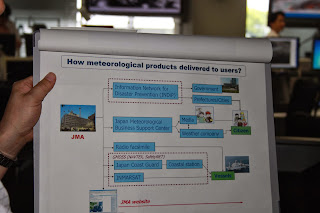20,000 participants gathered today for the Tone river drills. Although the majority consisted of suibo (flood fighting), firefighting and military personnel, this drill is also open to the public. From arrival to departure, everything was catered to.
After arriving on site, guided by about 20 traffic aides, a new bus transported us from the parking lot to the actual drill site. Many vans and stands offered demonstrations, such as knot tying, first aid, typhoon or earthquake simulations, oil absorbing products and inflatable dams. Awareness was also created by one stand where you could put on special glasses that make you experience what a color blind person would see when watching the average map of dangerous sites in green, yellow and red. We walked around between strategically based toilets and five mascots to get to our spot.
The main event was to sit in tents and watch the actual drills unfold (on the screen) in front of us. First of all we enjoyed an opening ceremony with taiko drums, and several speeches in Japanese. The different divisions responsible for flood fighting then reported for duty one by one. Next different drills were enacted, such as over topping and water seepage through the subsoil of the levee. A big difference with the Netherlands, aside from the military precision everyone executes, is the amount of bamboo used in emergency measures. Just as we were set to leave, the military rescue of people on rafts in the river started.


























































